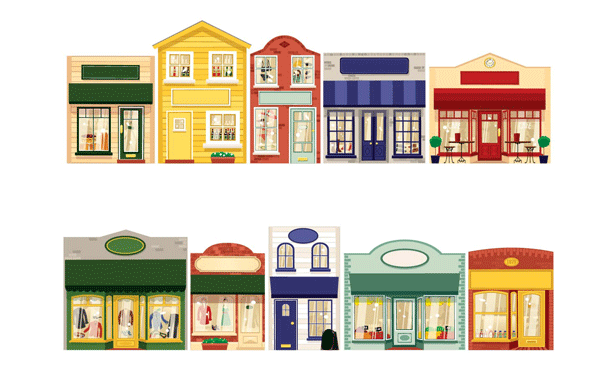Ecommerce is having a big impact on brick-and-mortar retail, including daily needs and experiential modes. While investors have been focusing on these retail niches as a way to protect against ecommerce, a new paper from David Shulman, senior economist for the UCLA Ziman Center for Real Estate and UCLA Anderson Forecast, shows that ecommerce is taking a growing share from retail spending. Ecommerce currently accounts for 8.9% of all retail sales—which generally puts retail investors at ease—however, that number includes automobile, gas, auto parts and restaurants, all of which are not “amenable to ecommerce competition,” according to Shulman's research. When you adjust for those retail classes, ecommerce's bite of retail spending actually jumps up to 15%. For grocery, that number is growing rapidly. The paper cites a Goldman Sachs report forecasting ecommerce will account for 10% to 20% of grocery sales alone in the next decade. Now, Amazon's acquisition of Whole Foods has highlighted the growth, and forecasted future growth, of ecommerce. To find out why this is significant for the brick-and-mortar market and why ecommerce is poised to continue to take an increasing share from retail spending, we sat down with Schulman for an interview.
GlobeSt.com: There has been a lot of discussion about Amazon's acquisition of Whole Foods, and if it has positive or negative implications for brick-and-mortar retail. What is your take?
David Shulman: Last miles are important to ecommerce, so having a physical presence near a population makes sense. The form of that physical presence is still up in the air. For Amazon, I think this is R&D. If you are going to have a physical presence in a neighborhood, it may mean a wholesale reconfiguration in a store. If BOPIS (buy online, pick up in store) is going to be widespread, people aren't going to be walking through aisles; they are going to be going to lockers to pick up goods. That will also mean a reconfiguration of parking at ingress and egress. It gets very complicated, and it is going to require spending in a physical layout of the store and the physical layout of the store where the shopping center lives.
GlobeSt.com: Your recent paper for UCLA shows that ecommerce is now the 'main event.' Do you think that is true even as Amazon moves into brick-and-mortar retail?
Shulman: I think that is a negative for brick-and-mortar, because if Amazon gains share, it will hurt existing retail. People see Amazon going into stores, and think that is a good thing for retail. I see it as letting the fox into the chicken coop. When you have Amazon in malls, you'll be able to order other goods from Amazon while you are in the store, and customers won't go to other stores.
GlobeSt.com: In the past few years, retail investors have adopted daily needs retail strategies as a way to protect against ecommerce growth.
Shulman: Grocery was viewed to be immune from ecommerce, and now I don't think that is the case. In my paper, I cite two Goldman Sachs reports that show grocery is 3% of ecommerce sales today, but predicts that it will be 10% to 20% by 2027. I think the share is going to grow. Amazon has put Whole Foods online as well, so you can already order Whole Foods online though Amazon. They have moved very quickly to integrate Whole Foods into the Amazon catalog. If investors thought that being in grocery-anchored centers was a way to avoid ecommerce competition, they are going to have trouble. Amazon is also talking about getting into the drug business, and we saw CVS and Walgreens stock fall as soon as that announcement came out.
GlobeSt.com: Do you think that ecommerce grocery models will be successful outside of cities?
Shulman: Whole Foods is in high-end suburban markets and urban markets, so that is apparently the markets that Amazon is going after. You can't leave Wal-Mart out of this, however. Wal-Mart is now going head-to-head with Amazon, and Wal-Mart will cover lower-income markets. The Wal-Mart shopper isn't a Whole Foods shopper. It will be geographically widespread.
GlobeSt.com: How will the move to ecommerce more broadly impact brick-and-mortar retail in the long term?
Shulman: I think there is going to be less retail space. Quality assets and well-located assets aren't going to go away. The questions are: how profitable will it be; how much capital will you need to maintain it; and what is the appropriate cap rate? My argument is that the class-A mall business is moving from a great business to a good business. That is the way I would characterize it. My sense is that a lot of tertiary retail is probably going to go away or see a change in use. The high quality retail will remain high quality retail, but the sales growth may be less, the rent growth may be less and it will cost more to maintain it. There are a lot of B- and C-class malls that will go away. There is no question about that. The question is over the 200 class-A malls in the best locations.
Ecommerce is having a big impact on brick-and-mortar retail, including daily needs and experiential modes. While investors have been focusing on these retail niches as a way to protect against ecommerce, a new paper from David Shulman, senior economist for the UCLA Ziman Center for Real Estate and UCLA Anderson Forecast, shows that ecommerce is taking a growing share from retail spending. Ecommerce currently accounts for 8.9% of all retail sales—which generally puts retail investors at ease—however, that number includes automobile, gas, auto parts and restaurants, all of which are not “amenable to ecommerce competition,” according to Shulman's research. When you adjust for those retail classes, ecommerce's bite of retail spending actually jumps up to 15%. For grocery, that number is growing rapidly. The paper cites a
GlobeSt.com: There has been a lot of discussion about Amazon's acquisition of Whole Foods, and if it has positive or negative implications for brick-and-mortar retail. What is your take?
David Shulman: Last miles are important to ecommerce, so having a physical presence near a population makes sense. The form of that physical presence is still up in the air. For Amazon, I think this is R&D. If you are going to have a physical presence in a neighborhood, it may mean a wholesale reconfiguration in a store. If BOPIS (buy online, pick up in store) is going to be widespread, people aren't going to be walking through aisles; they are going to be going to lockers to pick up goods. That will also mean a reconfiguration of parking at ingress and egress. It gets very complicated, and it is going to require spending in a physical layout of the store and the physical layout of the store where the shopping center lives.
GlobeSt.com: Your recent paper for UCLA shows that ecommerce is now the 'main event.' Do you think that is true even as Amazon moves into brick-and-mortar retail?
Shulman: I think that is a negative for brick-and-mortar, because if Amazon gains share, it will hurt existing retail. People see Amazon going into stores, and think that is a good thing for retail. I see it as letting the fox into the chicken coop. When you have Amazon in malls, you'll be able to order other goods from Amazon while you are in the store, and customers won't go to other stores.
GlobeSt.com: In the past few years, retail investors have adopted daily needs retail strategies as a way to protect against ecommerce growth.
Shulman: Grocery was viewed to be immune from ecommerce, and now I don't think that is the case. In my paper, I cite two
GlobeSt.com: Do you think that ecommerce grocery models will be successful outside of cities?
Shulman: Whole Foods is in high-end suburban markets and urban markets, so that is apparently the markets that Amazon is going after. You can't leave
GlobeSt.com: How will the move to ecommerce more broadly impact brick-and-mortar retail in the long term?
Shulman: I think there is going to be less retail space. Quality assets and well-located assets aren't going to go away. The questions are: how profitable will it be; how much capital will you need to maintain it; and what is the appropriate cap rate? My argument is that the class-A mall business is moving from a great business to a good business. That is the way I would characterize it. My sense is that a lot of tertiary retail is probably going to go away or see a change in use. The high quality retail will remain high quality retail, but the sales growth may be less, the rent growth may be less and it will cost more to maintain it. There are a lot of B- and C-class malls that will go away. There is no question about that. The question is over the 200 class-A malls in the best locations.
Want to continue reading?
Become a Free ALM Digital Reader.
Once you are an ALM Digital Member, you’ll receive:
- Breaking commercial real estate news and analysis, on-site and via our newsletters and custom alerts
- Educational webcasts, white papers, and ebooks from industry thought leaders
- Critical coverage of the property casualty insurance and financial advisory markets on our other ALM sites, PropertyCasualty360 and ThinkAdvisor
Already have an account? Sign In Now
*May exclude premium content© 2025 ALM Global, LLC, All Rights Reserved. Request academic re-use from www.copyright.com. All other uses, submit a request to [email protected]. For more information visit Asset & Logo Licensing.









